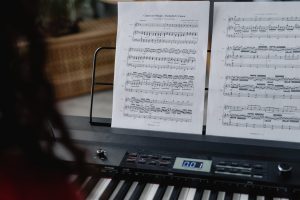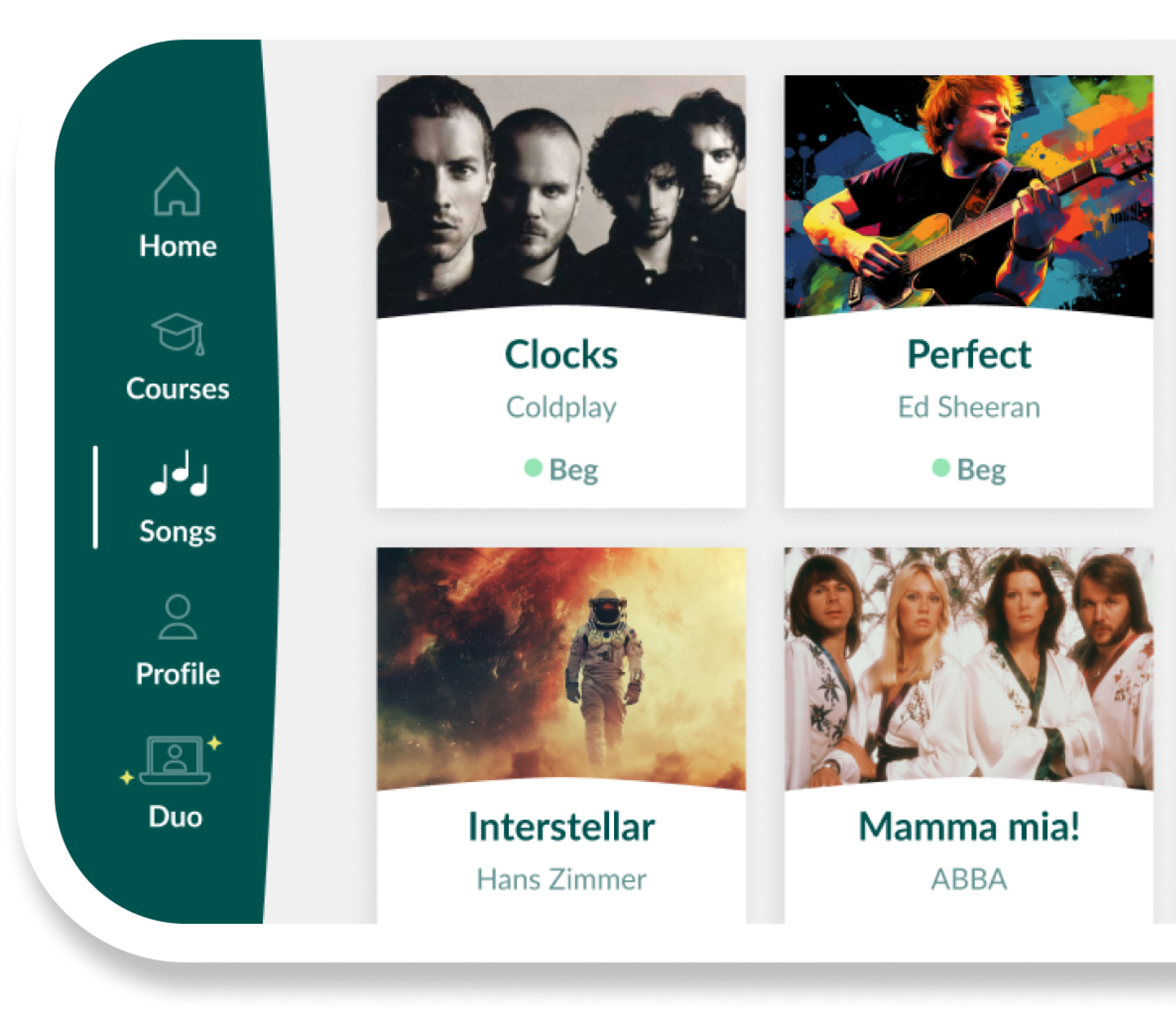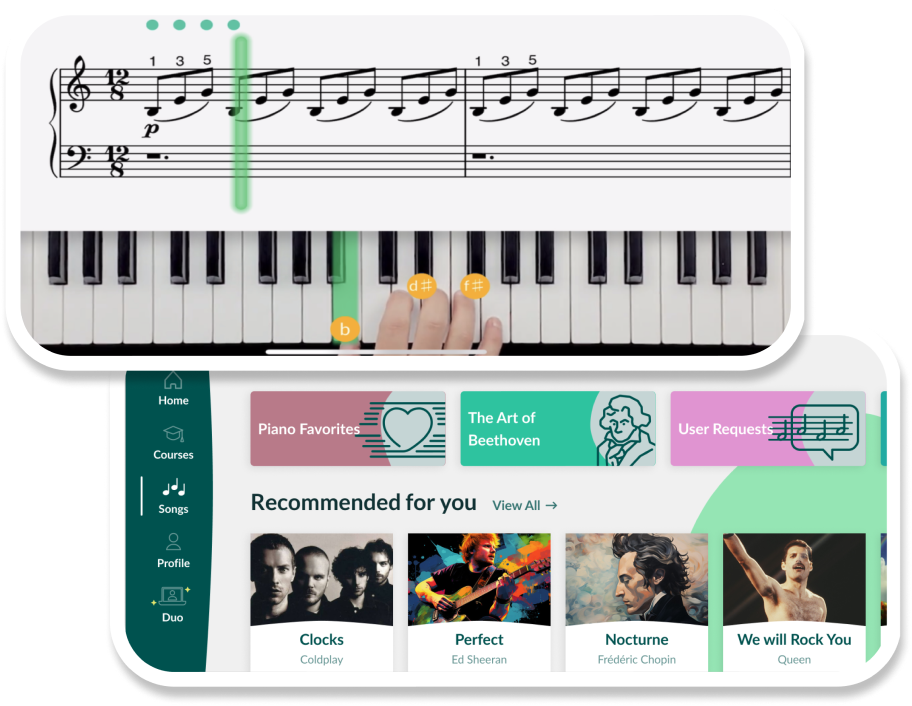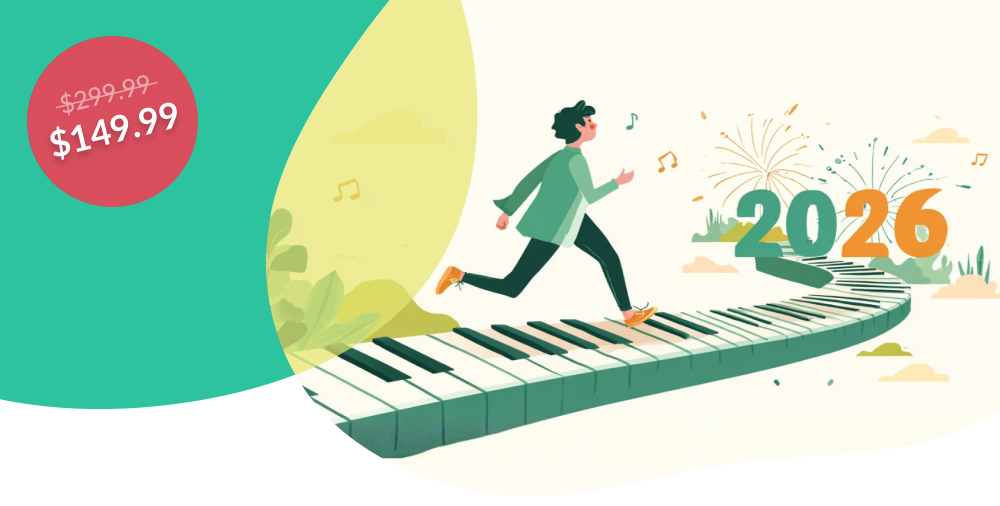Learning your favourite songs on the piano is one of the most fun and rewarding ways to get better as a musician. If you’re just starting out, finding easy piano songs for beginners is a smart move, they bring quicker progress and help you stay motivated. Whether you dream of playing pop hits, calming classics, or energetic movie themes, picking music you actually like makes every practice session more enjoyable.
Skoove’s collection has tons of easy piano songs picked just for beginners. Everything is clearly organized by style and skill level, so you can always find something that suits you, even if you’re brand new to the piano. As you practice, you’ll also get the chance to discover new genres and try out fresh songs as your skills grow.
If you want step-by-step guidance, check out our piano learning app. Each lesson slowly guides you through techniques and rhythm, letting you learn easy piano songs at your own pace. No matter what kind of music you love, you’ll find plenty of resources and beginner-friendly songs to help you build your skills, all while playing music you actually enjoy.
Table of Contents:
- “Hallelujah” by Leonard Cohen
- “Fly Me to the Moon” by Bart Howard
- “Lean on Me” by Bill Withers
- “My Heart Will Go On” by Celine Dion
- “The Wall” by Pink Floyd
- “Can’t Help Falling in Love” by Elvis Presley
- “Fur Elise” by Ludwig van Beethoven
- “Blue Danube” by Johann Strauss II
- “American Pie” by Don McLean
- “Twinkle, Twinkle, Little Star” by Jane Taylor
- “Mary Had a Little Lamb” by Sarah Josepha Hale
- “Happy Birthday to You” by Patty and Mildred J. Hill
- “Jingle Bells” by James Pierpont
- “Hot Cross Buns” – Traditional
- “The Sorcerer’s Apprentice” by Paul Dukas
“Hallelujah” by Leonard Cohen
| Difficulty level | Beginner |
| Key(s) | C major (Gb major Skoove lesson) |
| Meter | 4/4 |
| Technique | Single note in each hand; coordination |
| Try Adding | Sustain pedal for more atmosphere |
Leonard Cohen’s “Hallelujah” is widely regarded as one of the best easy piano songs for beginners. Its simple chord progressions and gentle melody make it accessible for those just starting out. The piece is in the key of G♭ major, which introduces learners to the black keys, an important technical step for developing keyboard familiarity beyond the white keys. Playing this song builds essential skills like hand coordination and smooth chord transitions, making it a practical choice for early repertoire.
Beyond technical benefits, “Hallelujah” offers rich emotional expression that helps beginners connect with the music on a deeper level. Its recognisable tune provides motivation and satisfaction while practicing, encouraging steady progress. Learning this timeless ballad not only strengthens fundamental piano techniques but also expands the player’s musical range and confidence, making it a valuable addition to any beginner’s song list.
Learn to play ‘Hallelujah’ by Leonard Cohen. Start a 7 day trial today – no card details required!
“Fly Me to the Moon” by Bart Howard
| Difficulty level | Intermediate |
| Key(s) | C major |
| Meter | Common time |
| Technique | Seventh chords |
| Try Adding | Rhythmic variation to the melody for a jazzy feel |
“Fly Me to the Moon” stands out as one of the most enduring jazz standards and an ideal entry point for beginner piano learners. Its inviting melody is supported by accessible arrangements that introduce basic seventh chords, essential for building a foundation in jazz harmony. The song’s structure breaks these chords into manageable sections, and pairs them with a simple, steady bass line, helping learners grow comfortable with richer jazz voicing while developing hand coordination.
Beyond chord work, this tune encourages mastery of scalic playing, which nurtures finger agility and reinforces the connection between scales and harmonies. “Fly Me to the Moon” also allows beginners to explore rhythmic nuance and dynamic phrasing unique to jazz. Incorporating this classic into your repertoire expands musical confidence and opens the door to more challenging jazz pieces in the future.
Learn to play ‘Fly Me to the Moon’ on piano. Start a 7 day trial today – no card details required!
“Lean on Me” by Bill Withers
| Difficulty level | Beginner |
| Key(s) | C major |
| C major | 4/4 |
| Technique | Independent playing in each hand |
| Try Adding | Dynamics to highlight the interesting movement between your hands |
Bill Withers’ “Lean on Me” is widely recognised as an approachable choice for beginners’ piano songs, thanks to its memorable melody and accessible arrangement. While both hands often move together rhythmically, the piece introduces learners to the concept of melodic independence. Each hand plays distinct notes, creating a fuller, more textured harmony that brings the song’s uplifting character to life.
Learning “Lean on Me” helps beginners develop coordination between their hands without overwhelming complexity. The interplay of melodies in each hand exposes new players to richer musical textures and encourages careful listening, which are important skills for progressing as a pianist. This combination of simplicity in rhythm and depth in harmony makes “Lean on Me” a rewarding and motivating addition to any beginner’s repertoire.
Learn to play ‘Lean on Me’ by Bill Withers on piano. Start a 7 day trial today – no card details required!
“My Heart Will Go On” by Celine Dion
| Difficulty level | Beginner |
| Key(s) | C major |
| Meter | 4/4 |
| Technique | Melody with bass notes. |
| Try Adding | Feel and articulation to the bass movement |
“My Heart Will Go On” is instantly recognisable as the leading theme from Titanic and offers an enjoyable learning experience for beginner piano players. The song’s approachable melody is both emotional and simple, inviting players to immerse themselves in expressive phrasing from the start. With straightforward bass movement in the left hand and a memorable lead line in the right, it gives learners the chance to work on coordination and hand independence without overwhelming complexity.
The song also introduces dotted rhythms and dynamic contrasts, essential elements for developing rhythmic precision and control. Practicing this piece helps piano beginners build confidence in their timing and encourages careful attention to musical details. Its cinematic quality and universal appeal make it a motivating addition to any early repertoire, ensuring that even simple performances feel dramatic and rewarding.
Learn to play ‘My Heart Will Go On’ by Celine Dion on piano. Start a 7 day trial today – no card details required!
“The Wall” by Pink Floyd
| Difficulty level | Beginner |
| Key(s) | D major |
| Meter | 4/4 |
| Technique | Hand coordination |
| Try Adding | Variation to the pedal note articulation |
“The Wall” by Pink Floyd stands out as an excellent choice for piano beginners who want to experience playing legendary rock music on the piano without feeling overwhelmed. This classic tune is arranged in such a way that the right hand can confidently lead with the melody, a sequence that’s both familiar and satisfying to play, even for those just starting out. By isolating the main theme in your right hand, you get to focus on crafting musical phrases and mastering the song’s rhythmic feel, which helps build both confidence and a sense of accomplishment early on.
Meanwhile, the left hand is kept deliberately simple, anchoring the arrangement with a repeated pedal note pattern. This straightforward technique means you’re rarely required to coordinate complex chords or shifting shapes in the bass. Instead, your left hand provides a steady pulse and foundation for the music, supporting the right hand’s melody without competing for attention. It’s this clever use of repetition that transforms what could be a complicated rock anthem into an accessible, rewarding experience for piano learners, making sophisticated music feel perfectly within reach as you build your skills.
Learn to play ‘The Wall’ by Pink Floyd on piano. Start a 7 day trial today – no card details required!
“Can’t Help Falling in Love” by Elvis Presley
| Difficulty level | Intermediate |
| Key(s) | C major |
| Meter | 6/8 |
| Technique | Melody with bass notes |
| Try Adding | Dynamics to convey more feeling |
“Can’t Help Falling in Love” by Elvis Presley is a beautiful and accessible choice for beginner piano learners looking to play something emotional and timeless. The arrangement often places the well-known melody in the right hand, allowing you to shape the tune expressively while keeping the left hand simple with broken chords or repeated patterns. This structure helps build coordination and confidence without adding pressure, letting you focus on bringing out the gentle, flowing quality of the song. With its steady rhythm and recognisable phrases, it’s an ideal piece to practice musical sensitivity and develop a smooth, relaxed playing style early on.
Learn to play ‘Can’t Help Falling in Love’ by Elvis Presley on piano. Start a 7 day trial today – no card details required!
“Fur Elise” by Ludwig van Beethoven
| Difficulty Level | Intermediate |
| Key | A Minor |
| Meter | 6/8 |
| Technique | Right hand melody, left hand broken chords |
| Try Adding | Coordination of dynamics between hands |
“Für Elise” by Ludwig van Beethoven is one of the most beloved and instantly recognisable pieces in classical piano repertoire, making it an excellent choice for beginners eager to connect with timeless music. This famous composition features a graceful, flowing melody that invites players to develop both technique and musicality. Many easy arrangements focus on the opening theme, where the right hand plays a charming a-minor motif while the left hand supports with simple bass notes, helping piano learners build coordination without feeling overwhelmed. The easy piano song also offers opportunities to practice expressive dynamics, as Beethoven marks the famous opening phrase to be played in pianissimo, encouraging a tender, delicate touch.
Learning “Für Elise” early in your piano journey can be deeply rewarding because it balances approachable technical demands with rich emotional content. Most beginner tutorials emphasise hand positioning that minimizes tension, such as sliding the right hand gently to reach the occasional sharp notes without twisting the wrist. As you practice the alternating notes and simple skips that form the main theme, focus on smooth finger transitions and soft dynamics to capture Beethoven’s intended tone. Over time, mastering this piece builds finger independence and introduces phrasing subtleties that prepare you for more advanced classical works, all while connecting you with a centuries-old masterpiece full of mystery and expressive warmth.
Learn to play ‘Fur Elise’ by Ludwig van Beethoven on piano. Start a 7 day trial today – no card details required!
“Blue Danube” by Johann Strauss II
| Difficulty Level | Beginner |
| Key | C major |
| Meter | 3/4 |
| Technique | Playing legato |
| Try Adding | An accented first beat to feel like a waltz |
“The Blue Danube” by Johann Strauss II is a timeless waltz that brings elegance and charm to beginner piano players. Its easy flowing melody and gentle 3/4 rhythm create a graceful dance feel that’s both approachable and rewarding to play. Many easy arrangements focus on breaking down the left hand into simple, repetitive patterns that support the swirling right-hand melody, helping learners develop coordination while capturing the piece’s distinctive, lilting character.
Playing “The Blue Danube” offers a wonderful opportunity to practice smooth phrasing and steady rhythm, essential skills for any piano player. The steady pulse of the waltz encourages control over timing, while the clear melodic lines let you explore expressive dynamics and subtle articulation. Whether you follow a video tutorial or explore simplified sheet music, this beloved classic provides a joyful, musical challenge perfectly suited to early stages of piano learning.
Learn to play ‘Blue Danube’ by Johann Strauss on piano. Start a 7 day trial today – no card details required!
“American Pie” by Don McLean
| Difficulty Level | Beginner |
| Key | C major |
| Meter | 4/4 |
| Technique | Staying focused through repetitive melody |
| Try Adding | Articulation to make the rhythm more interesting |
“American Pie” by Don McLean is a classic folk rock song that’s surprisingly easy, making it a fantastic piece to add to your repertoire. This song is memorable and flows smoothly, typically played with the right hand while the left hand supports with simple chords or broken patterns. This arrangement allows you to focus on capturing the storytelling and emotional depth of the song without being overwhelmed by complex technical demands.
Playing “American Pie” provides an excellent opportunity to practice steady rhythm and chord transitions, essential skills for budding pianists. Its moderate tempo and clear structure make it approachable, while the familiar tune keeps you motivated as you learn. Whether you use easy piano sheet music or guided video lessons, this iconic song invites you to connect with its nostalgic mood and develop expressive phrasing that brings the music to life.
Learn to play ‘American Pie’ by Don McLean on piano. Start a 7 day trial today – no card details required!
“Twinkle, Twinkle, Little Star” by Jane Taylor
| Difficulty Level | Beginner |
| Key | C major |
| Meter | 4/4 |
| Technique | Melody with bass notes |
| Try Adding | Sustain pedal for smoother transitions |
“Twinkle, Twinkle, Little Star” by Jane Taylor is a beloved easy beginner’s piano song that perfectly blends simplicity with musical charm. Its gentle, repetitive melody stays within a small five-finger range, making it ideal for those taking their very first steps on the keyboard. Often taught using just the right hand at first, this tune helps new players develop basic finger independence and note recognition, while the straightforward rhythm supports steady timing and coordination.
As piano learners grow more confident, adding the left hand becomes a natural next step, usually starting with simple bass notes or basic chords to accompany the melody. This gradual introduction of both hands playing together encourages coordination and deepens understanding of harmonies, laying the foundation for more complex pieces. “Twinkle, Twinkle, Little Star” also offers excellent opportunities to practice phrasing and expression, helping players bring warmth and life to this classic nursery rhyme.
Learn to play ‘Twinkle, Twinkle, Little Star’ by Jane Taylor on piano. Start a 7 day trial today – no card details required!
“Mary Had a Little Lamb” by Sarah Josepha Hale
| Difficulty Level | Beginner |
| Key | C major |
| Meter | 4/4 |
| Technique | Playing legato |
| Try Adding | More varied phrasing with the legato feel |
“Mary Had a Little Lamb” by Sarah Josepha Hale is a perfect beginner’s piano song that combines simplicity and familiarity to make learning the piano enjoyable and accessible. The melody is straightforward and memorable, typically played with the right hand within a limited range, which helps new pianists build finger strength and accuracy without feeling overwhelmed. Its steady rhythm and repetitive pattern offer excellent practice for developing consistent timing and coordination.
As players become more comfortable, the left hand can be introduced with simple single notes or basic chords to accompany the tune, fostering hand independence and a growing understanding of harmony. This classic nursery rhyme not only builds foundational skills but also encourages expressive playing, allowing learners to focus on dynamics and phrasing that bring the music to life. Whether you enjoy classical pieces or folk and rock songs, “Mary Had a Little Lamb” offers a gentle, rewarding introduction that aligns perfectly with your taste for approachable yet meaningful piano music.
Learn to play ‘Mary Had a Little Lamb’ by Sarah Josepha Hale on piano. Start a 7 day trial today – no card details required!
“Happy Birthday to You” by Patty and Mildred J. Hill
| Difficulty Level | Beginner |
| Key | C major |
| Meter | 3/4 |
| Technique | Melody leaps |
| Try Adding | Dynamics when repeating for a more exciting performance |
“Happy Birthday to You” by Patty and Mildred J. Hill is a simple and universally loved tune that makes for a perfect easy piano song to play. Its familiar melody is not hard to learn, helping new players build confidence while practicing steady rhythm and hand coordination. This cheerful song invites expressive playing, making it a joyful introduction to piano for learners of all ages.
Learn to play ‘Happy Birthday to You’ by Patty and Mildred J. Hill on piano. Start a 7 day trial today – no card details required!
“Jingle Bells” by James Pierpont
| Difficulty Level | Beginner |
| Key | C major |
| Meter | 4/4 |
| Technique | Playing with one hand |
| Try Adding | Articulation to get that festive feel |
“Jingle Bells” by James Lord Pierpont is a lively and timeless tune that has become synonymous with winter festivities worldwide, despite its origins outside of Christmas. Written in 1857 and originally titled “The One Horse Open Sleigh,” the song was inspired by the exhilaration of sleigh races in Medford, Massachusetts. Its catchy melody and joyful lyrics, capturing scenes of dashing through the snow, make it accessible and fun for piano players of all levels.
Many beginner arrangements emphasise the memorable right-hand melody paired with simple left-hand accompaniments, allowing learners to enjoy playing this festive classic without being overwhelmed by technical challenges.
Playing “Jingle Bells” offers a wonderful chance to practice steady rhythm, hand coordination, and lively expression, qualities essential for holiday music and beyond. The song’s bright, repetitive motifs help build finger dexterity and timing, while its joyful spirit encourages expressive phrasing that brings warmth and energy to your playing. Whether you’re practicing for seasonal performances or simply want to add a celebrated favourite to your repertoire, “Jingle Bells” is a perfect easy piano song to brighten your piano journey and share the festive cheer.
Learn to play ‘Jingle Bells’ by James Pierpont on piano. Start a 7 day trial today – no card details required!
“Hot Cross Buns” – Traditional
| Difficulty Level | Beginner |
| Key | C major |
| Meter | 4/4 |
| Technique | Playing with one hand |
| Try Adding | Legato for smooth transitions |
“Hot Cross Buns” is a classic beginner piano song that’s perfect for developing basic finger coordination and timing. Its simple, repetitive melody makes it easy to memorise, while the straightforward rhythm helps new players build confidence in their timing and note accuracy. Often taught with just the right hand initially, this traditional tune offers a gentle introduction to the keyboard and lays a solid foundation for more complex songs.
Learn to play ‘Hot Cross Buns’ – Traditional on piano. Start a 7 day trial today – no card details required!
“The Sorcerer’s Apprentice” by Paul Dukas
| Difficulty Level | Beginner |
| Key | A minor |
| Meter | 3/4 |
| Technique | Accidentals |
| Try Adding | Articulation for a cheeky interesting feel |
The Sorcerer’s Apprentice might not be the first song you consider for easy piano, but it’s a wonderfully engaging choice that quickly feels rewarding under your fingers. The piece features catchy, repetitive rhythms and a straightforward time signature, making it easier to learn than its reputation might suggest. Plus, the use of accidental notes, those adventurous black keys, brings a playful twist to the melody, helping you become more confident as you explore new corners of the keyboard and develop a lively touch.
Not only is this tune approachable, it’s also perfect for experimenting with cheeky articulation and expressive details. Each phrase invites you to add your own character, whether you want to highlight the sneaky feel of the apprentice or the magical whirlwind of the enchanted broom. Working on The Sorcerer’s Apprentice is a fun way to build your skills with dynamics, articulation, and keyboard navigation, making it an imaginative and skill-building addition to any early piano repertoire.
Learn to play ‘The Sorcerer’s Apprentice’ by Paul Dukas on piano. Start a 7 day trial today – no card details required!
How to play easy songs on piano?
Tackling a variety of easy songs is one of the most enjoyable, and effective, ways to build confidence at the piano. As you begin, focus on songs with straightforward rhythms and manageable hand coordination. Start simple; for example, “Fly Me to the Moon” is a great easy song before trying something like “Für Elise,” which requires a bit more independence between your hands. Take your time and savour steady progress: play slowly at first, adding speed only as your control improves. Most importantly, select beginners’ songs you genuinely enjoy, as this will keep you motivated and inspired to practice.
Top tips for successful beginner practice:
- Start with simple melodies and songs that have fewer notes and predictable rhythms, like “American Pie,” are easier to learn and memorise.
- Practice hands separately first. Get comfortable with each hand on its own, especially when tackling pieces that need coordination, such as “Für Elise.”
- Play slowly before building up speed. Developing accuracy at a slow pace leads to strong habits and fewer mistakes.
- Keep time. As you build up tempo, use a metronome or apps like Skoove to help keep your rhythm steady.
- Use interactive tools. Lesson platforms and play alongs can break songs into manageable steps and offer instant feedback.
- Add your own feel. Once you’re confident playing the notes, focus on dynamics and articulation, experimenting with how you shape each phrase for personal expression.
Where to go after mastering easy songs?
Once you’re comfortable with beginner-level piano songs, you’re ready to explore even more exciting music. Look for new songs by considering factors like hand independence, the number of notes in each hand, and overall rhythmic complexity. With these tips, finding beginner sheet music becomes a breeze, and before long, you’ll be prepared to take on intermediate works and explore fresh challenges.
Skoove piano learning app offers hundreds of easy and inspiring songs, from classical favorites like Bach to iconic hits from The Beatles. Whether you want to master the basics or take on intermediate repertoire, you’ll find plenty of opportunities to grow. Now that you’ve begun your journey with easy piano songs, remember that it’s just the start- the more you play, the more enjoyable your musical adventure becomes.
Enjoy the process, keep exploring, and happy practicing!
Start playing favourite easy piano songs
Author of this blog post:

Eddie Bond is a multi-instrumentalist performer, composer, and music instructor currently based in Seattle, Washington USA. He has performed extensively in the US, Canada, Argentina, and China, released over 40 albums, and has over a decade experience working with music students of all ages and ability levels.
Published by the Skoove team















